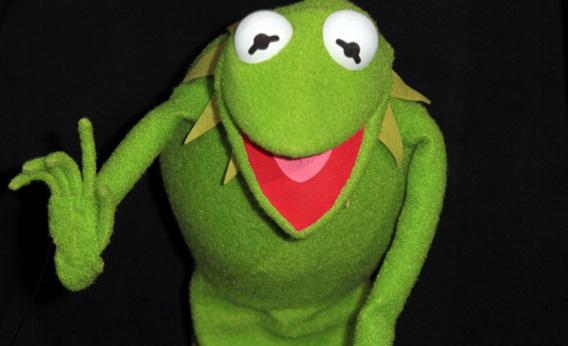You are reading this article because of Kermit the Frog. This is true in the conventional sense of its arriving on the occasion of The Muppets, the charming new movie in which he returns as the ringleader of Jim Henson’s vaudeville menagerie. As ever, Kermit presents a study in balance: His innate humility counters his naked ambition, his earnest sentimentality complements the company’s ironic capering, and the shy reediness of his singing voice strengthens the appeal of lyrics steeled with resolution.
More to the point, you are reading this article because the writer sat in front of PBS one day in the late 1970s and brightened immeasurably at the sight of Kermit the Frog doing a stand-up for the Sesame Street News Flash. In the moment, the frog—glamorous in his trench coat, stirring in his dauntlessness—gave the kid the idea that it would be fun to be a reporter. The child went forth from his native swamp and did just that, or something akin to it, and now he’s hardly sure that this very appreciation of Kermit properly qualifies as cultural journalism. There is nothing like critical distance in it. Pretending to a neutral position is impossible. You have stumbled into the mind of a member of The Muppet Show Fan Club—a person for whom Kermit qualifies as not a cultural but a religious icon and thus as a test of the limits of criticism.
Here is the official membership certificate: Wearing a generous head-shot grin, the frog pops his boyish head and princely collar through the O of the word show. Below this logo, he has signed his name as the organization’s president with a green pen and a sober hand. (Meanwhile, the recording secretary, Miss Piggy, has looped her signature in pink ink and smooched an XX into the paraph.) Here is yellowing photo evidence of a classic Kermit posable plush toy, the prize of what once was a teeming sculpture gallery of graven images. That toy suffered traumas beyond any known to the Velveteen Rabbit. The plush pilled prolifically. The Velcro patches at its wrists deadened with overuse so that posing was no longer possible. The buoyant irises on the bulging eyes required serial re-inkings: This was a doll blinded by love.
There was a set of Kermit the Frog bedding that matched the set of Kermit the Frog curtains that hung in the boyhood bedroom until about the age of 9, at which point there was a premature effort to put away childish things and switch to curtains decorated with NFL logos, which resulted in minor nightmares inspired by Tampa Bay’s Bucco Bruce. The spell was breaking anyhow as the Muppets entered the inevitable, regrettable, regressive era of Jim Henson’s Muppet Babies. They moved somewhere it was not natural to follow them.
If we had to get think-piecey about what the Muppets meant in their first mass moment and what their tenderest fans took from them, we might note that the years of Kermit’s ascent coincided with those of Woody Allen’s rise from cult farceur to major American filmmaker, and we would notice that the amphibious banjoist, with his nebbishy neuroses and his Borscht Belt funny bone, strikes some of the same chords as the mammalian clarinetist. While we were at it, we could also observe that in its particular cleverness—in the rude mechanical self-reflexivity of its show about puttin’ on a show—The Muppet Show functioned as an educational program prepping Generation X for liberal-artistic activities ranging from drafting halfway decent papers on Tom Stoppard to overpraising NBC’s Community.
But we cannot get think-piecey. We cannot even manage a reading along the lines of one performed by The Onion under the headline “I Appreciate the Muppets on a Much Deeper Level Than You.” Appreciation has nothing to do with it. Can you appreciate your own retinae? Perhaps your own childhood tropism to some charismatic creature—a willful identification with the trickster glibness of Bugs Bunny, say—has led you to a similar space, where it would be impossible to conduct the sort of self-examination that Jonathan Lethem does in his essay about watching Star Wars 21 times at age 13 in the summer of its release: “I was teaching myself to package my own craving for solitude, and my own obsessive tendencies, as something to be admired.” This is a cousin to the Kermit business but, crucially, an older cousin. Certain things that happen before the age of reason exists beyond the reach of ratiocination.
Settling in to watch the original Muppet Movie for the first time in decades, I braced myself for a swoon of nostalgia. The thing is, in order to feel nostalgic for a thing, you need to have gotten away from it at some point. Watching The Muppet Movie simply felt like a nice night at home—and not, like, hometown-home, either. It met me right where I live. Humming along to the musical numbers, I recognized the questions that play in my head every time I see City of Quartz on a bookshelf or Chinatown in the listings (“Hey, L.A., where have you gone?” Kermit wonders early in the road trip) or a fat man in a red suit (“Does Santa Claus believe in you?” ask the Electric Mayhem in a psychedelic koan). No revelations were possible, but the viewing did give me space to wonder why I have hopped at the chance to eat frogs’ legs everywhere from the Bund in Shanghai to the boardwalk at Coney Island. Is this the blasphemy of an adult drawing a firm line between men and Muppets? Or the act of a child who has heard that he is what he eats?
